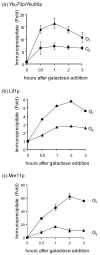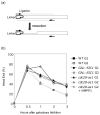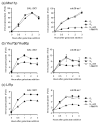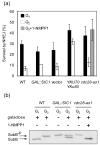Regulation of repair choice: Cdk1 suppresses recruitment of end joining factors at DNA breaks
- PMID: 19699692
- PMCID: PMC2748135
- DOI: 10.1016/j.dnarep.2009.07.007
Regulation of repair choice: Cdk1 suppresses recruitment of end joining factors at DNA breaks
Abstract
Cell cycle plays a crucial role in regulating the pathway used to repair DNA double-strand breaks (DSBs). In Saccharomyces cerevisiae, homologous recombination is primarily limited to non-G(1) cells as the formation of recombinogenic single-stranded DNA requires CDK1-dependent 5' to 3' resection of DNA ends. However, the effect of cell cycle on non-homologous end joining (NHEJ) is not yet clearly defined. Using an assay to quantitatively measure the contributions of each repair pathway to repair product formation and cellular survival after DSB induction, we found that NHEJ is most efficient at G(1), and markedly repressed at G(2). Repression of NHEJ at G(2) is achieved by efficient end resection and by the reduced association of core NHEJ proteins with DNA breaks, both of which depend on the CDK1 activity. Importantly, repression of 5' end resection by CDK1 inhibition at G(2) alone did not fully restore either physical association of Ku/Dnl4-Lif1 with DSBs or NHEJ proficiency to the level at G(1). Expression of excess Ku can partially offset the inhibition of end joining at G(2). The results suggest that regulation of Ku/Dnl4-Lif1 affinity for DNA ends may contribute to the cell cycle-dependent modulation of NHEJ efficiency.
Figures





Similar articles
-
Role of Dnl4-Lif1 in nonhomologous end-joining repair complex assembly and suppression of homologous recombination.Nat Struct Mol Biol. 2007 Jul;14(7):639-46. doi: 10.1038/nsmb1261. Epub 2007 Jun 24. Nat Struct Mol Biol. 2007. PMID: 17589524
-
Yeast Nej1 is a key participant in the initial end binding and final ligation steps of nonhomologous end joining.J Biol Chem. 2011 Feb 11;286(6):4931-40. doi: 10.1074/jbc.M110.195024. Epub 2010 Dec 13. J Biol Chem. 2011. PMID: 21149442 Free PMC article.
-
Recruitment and dissociation of nonhomologous end joining proteins at a DNA double-strand break in Saccharomyces cerevisiae.Genetics. 2008 Mar;178(3):1237-49. doi: 10.1534/genetics.107.083535. Epub 2008 Feb 3. Genetics. 2008. PMID: 18245831 Free PMC article.
-
Consider the workhorse: Nonhomologous end-joining in budding yeast.Biochem Cell Biol. 2016 Oct;94(5):396-406. doi: 10.1139/bcb-2016-0001. Epub 2016 Mar 31. Biochem Cell Biol. 2016. PMID: 27240172 Free PMC article. Review.
-
Mechanisms of DNA double strand break repair and chromosome aberration formation.Cytogenet Genome Res. 2004;104(1-4):14-20. doi: 10.1159/000077461. Cytogenet Genome Res. 2004. PMID: 15162010 Review.
Cited by
-
Repair of double-strand breaks by end joining.Cold Spring Harb Perspect Biol. 2013 May 1;5(5):a012757. doi: 10.1101/cshperspect.a012757. Cold Spring Harb Perspect Biol. 2013. PMID: 23637284 Free PMC article. Review.
-
DNA repair choice defines a common pathway for recruitment of chromatin regulators.Nat Commun. 2013;4:2084. doi: 10.1038/ncomms3084. Nat Commun. 2013. PMID: 23811932 Free PMC article.
-
Stabilization of the metaphase spindle by Cdc14 is required for recombinational DNA repair.EMBO J. 2017 Jan 4;36(1):79-101. doi: 10.15252/embj.201593540. Epub 2016 Nov 16. EMBO J. 2017. PMID: 27852625 Free PMC article.
-
DNA Repair in Haploid Context.Int J Mol Sci. 2021 Nov 17;22(22):12418. doi: 10.3390/ijms222212418. Int J Mol Sci. 2021. PMID: 34830299 Free PMC article. Review.
-
Controlling DNA-end resection: a new task for CDKs.Front Genet. 2013 Jun 3;4:99. doi: 10.3389/fgene.2013.00099. eCollection 2013. Front Genet. 2013. PMID: 23760669 Free PMC article.
References
-
- Kolodner RD, Putnam CD, Myung K. Maintenance of genome stability in Saccharomyces cerevisiae. Science. 2002;297:552–557. - PubMed
-
- Wyman C, Kanaar R. DNA double-strand break repair: all’s well that ends well. Annu Rev Genet. 2006;40:363–383. - PubMed
-
- Shrivastav M, De Haro LP, Nickoloff JA. Regulation of DNA double-strand break repair pathway choice. Cell Res. 2008;18:134–147. - PubMed
-
- Daley JM, Palmbos PL, Wu D, Wilson TE. Nonhomologous end joining in yeast. Annu Rev Genet. 2005;39:431–451. - PubMed
-
- Lieber MR, Ma Y, Pannicke U, Schwarz K. The mechanism of vertebrate nonhomologous DNA end joining and its role in V(D)J recombination. DNA Repair (Amst) 2004;3:817–826. - PubMed
Publication types
MeSH terms
Substances
Grants and funding
LinkOut - more resources
Full Text Sources
Molecular Biology Databases
Miscellaneous

